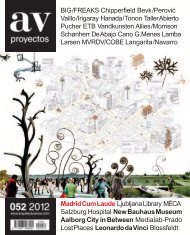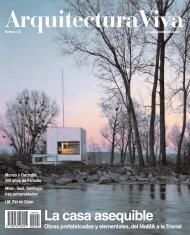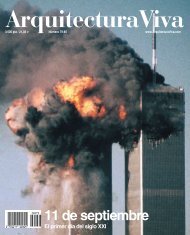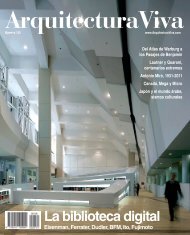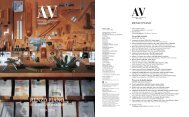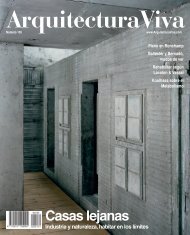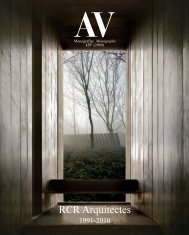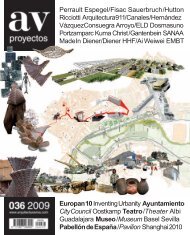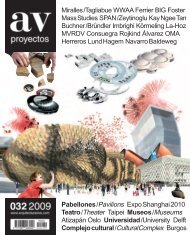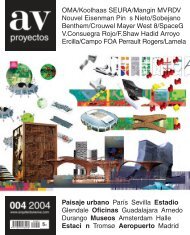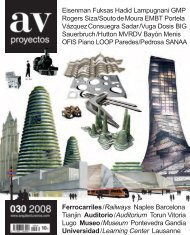LA ESCUELA GLOBAL - Arquitectura Viva
LA ESCUELA GLOBAL - Arquitectura Viva
LA ESCUELA GLOBAL - Arquitectura Viva
You also want an ePaper? Increase the reach of your titles
YUMPU automatically turns print PDFs into web optimized ePapers that Google loves.
Muros maestros<br />
La escuela es muros y maestros. <strong>Arquitectura</strong> y pedagogía construyen los edificios<br />
escolares, y queremos pensar que su importancia es pareja. No es así: una escuela<br />
puede prescindir de los muros, pero no de los maestros. Si André Malraux teorizó<br />
un museo sin muros que usaría la fotografía como herramienta de acceso a la<br />
belleza, Marshall McLuhan propuso un aula sin muros que emplearía los medios<br />
de comunicación como instrumentos de acceso al conocimiento, y tanto uno como<br />
otro entendieron la ausencia de muros como la representación del traslado de la<br />
esfera física a la virtual. Sin embargo, el mundo inmaterial de las imágenes, los<br />
medios y las redes excluye la dimensión emocional de la presencia, y son precisamente<br />
el escalofrío estético de la proximidad o el estímulo intelectual de la<br />
oralidad los que establecen el contacto con la obra maestra o el maestro escolar.<br />
Podemos prescindir de los muros, pero no del espacio físico donde se desarrolla<br />
la relación entre maestro y discípulo.<br />
Ese componente espacial del ámbito educativo se extiende al trayecto de<br />
la casa a la escuela, un itinerario que habitualmente supone el primer contacto<br />
íntimo del niño con su medio físico. Sea tutelado o autónomo, sea individual o<br />
en grupo, sea urbano o rural, el recorrido desde el útero tibio del hogar hasta el<br />
recinto coral del colegio es una apertura al mundo y a los otros, pero también una<br />
exploración de la ciudad inmediata o de los campos próximos, y esos paisajes<br />
cotidianamente transitados encierran tantas enseñanzas como los muros de la<br />
escuela, porque en ellos reside el riesgo del azar y el placer del descubrimiento.<br />
La escuela es un lugar tanto como un viaje: un viaje material que reconoce el<br />
territorio y un viaje moral que abre las puertas a la sociabilidad y las ventanas al<br />
conocimiento, en una mudanza que lleva al niño o al joven a la disciplina de los<br />
límites que establece un entorno colectivo y al engarce de su personalidad en la<br />
exigente coreografía de lo compartido.<br />
El recientemente desaparecido Fabián Estapé —un gran economista que fue<br />
también biógrafo de Ildefonso Cerdá— solía decir que un hombre es ‘una madre<br />
y un bachillerato’, expresión castiza que subraya nuestra deuda con la familia y<br />
la escuela, crisoles esenciales de la formación que enriquece a la persona tanto<br />
como la habilita para insertarse en el mundo social y laboral. Y tanto en la casa<br />
como en el aula, la arquitectura de los espacios no es tan importante como la<br />
arquitectura de las relaciones, la naturaleza de los vínculos que se establecen<br />
entre los miembros de la familia o entre los miembros de la comunidad escolar.<br />
Necesitamos excelentes edificios, pero necesitamos aún más maestros excelentes,<br />
y nada de esto puede lograrse sin la estima social de la docencia y el apoyo<br />
de las familias a las aulas. La mejora de la educación no reside en los programas<br />
o en las construcciones, sino en los profesores. El muro maestro de la escuela<br />
global no es el muro sino el maestro.<br />
Luis Fernández-Galiano<br />
A school is walls and masters. Architecture and<br />
pedagogy make up the school buildings, and we want<br />
to think that their importance is equivalent. It is not so:<br />
a school can do without walls, but not without masters.<br />
If André Malraux theorized about a museum without<br />
walls which would use photography as a tool of access<br />
to beauty, Marshall McLuhan proposed a classroom<br />
without walls that would use the communication media<br />
as tools of access to knowledge, and both of them<br />
understood the absence of walls as the representation of<br />
the transfer from the physical sphere to the virtual one.<br />
However, the immaterial world of images, media and<br />
networks excludes the emotional dimension of presence,<br />
and it is precisely the aesthetic shudder of proximity<br />
or the intellectual stimulus of orality that establish the<br />
contact with the masterpiece or the schoolmaster. We<br />
can do without walls, but not without the physical space<br />
where the relationship between master and disciple<br />
takes place.<br />
That spatial component of the educational space<br />
extends to the itinerary from home to school, a path that<br />
is usually the first close contact of the child with his<br />
or her physical context. Be it tutored or autonomous,<br />
individual or in a group, urban or rural, the passage<br />
from the warm uterus of the home to the choral precinct<br />
of the school means opening up to the world and to<br />
others, but it is also an exploration of the nearby city or<br />
fields, and these daily transited landscapes enclose as<br />
many teachings as the walls of the school, because they<br />
harbor haphazard risks and pleasurable discoveries.<br />
The school is both a place and a journey: a material<br />
journey that scouts the territory and a moral journey<br />
that opens the doors to sociability and the windows<br />
to knowledge, during a voyage that takes the child or<br />
teenager to the discipline of boundaries established by<br />
a collective environment and to the insertion of his or<br />
her personality in the demanding choreography of the<br />
shared realm.<br />
The recently deceased Fabián Estapé – a prominent<br />
Spanish economist who was also the biographer of the<br />
influential town planner Ildefonso Cerdá – used to say<br />
that a man is ‘a mother and a baccalaureate’, a perhaps<br />
politically incorrect way of stressing our debt with<br />
family and school, essential cores of the education that<br />
enriches a person and prepares him or her to live and<br />
work in society. And both at home and in the classroom,<br />
the architecture of the spaces is not as important as the<br />
architecture of the relationships, the nature of the ties<br />
established among family members or among members<br />
of a school community. We need excellent buildings,<br />
but we need excellent masters even more, and none of<br />
this can be achieved without a greater social esteem for<br />
teachers and increased support of families to schools.<br />
The improvement of education does not reside in<br />
programs or in buildings, but in teachers. The master<br />
wall of the global school is not the wall but the master.<br />
2 2011 AV Monografías 152 AV Monographs 152 2011 3




